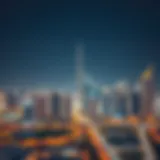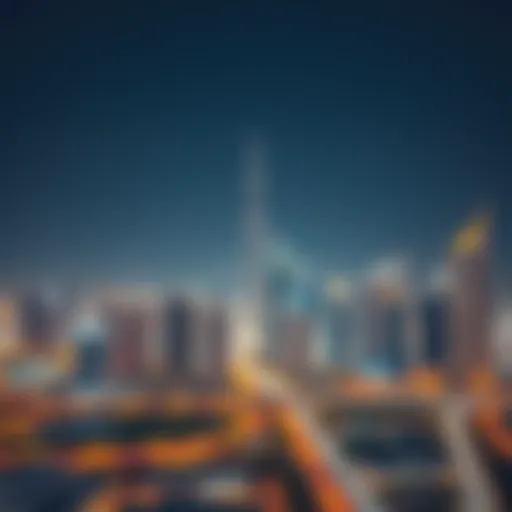Exploring Dubai's Downtown: Real Estate and Culture
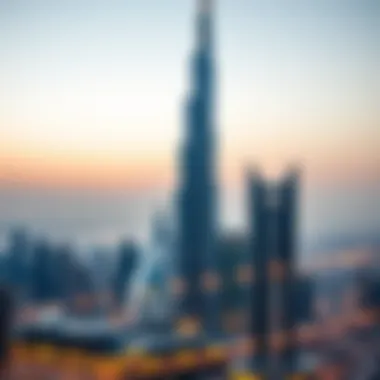
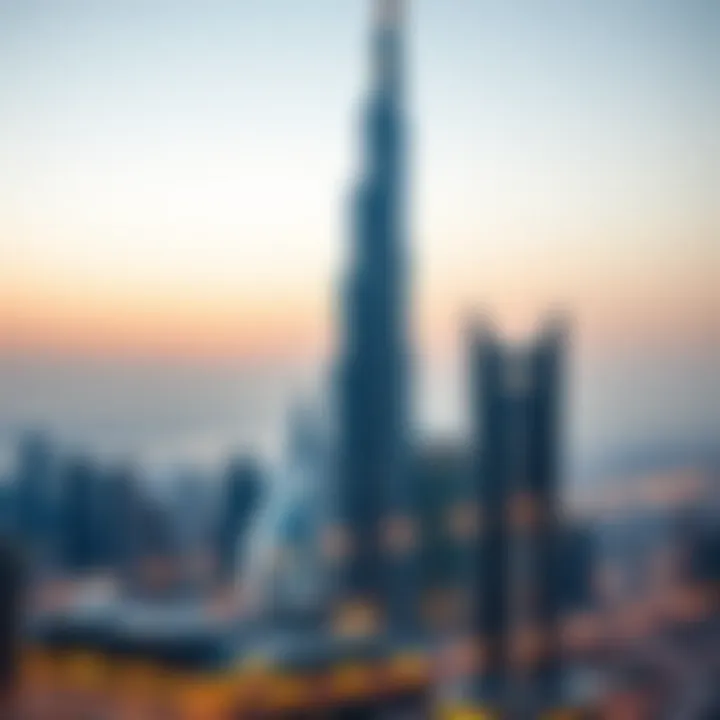
Intro
Downtown Dubai stands as a shining beacon of modernity, innovation, and cultural richness. It embodies the rapid transformation of a once desert landscape into a global hub, where towering skyscrapers, luxurious hotels, and world-class shopping converge. This dynamic area is not just about aesthetics; it also presents a unique tapestry of opportunities for investors and homebuyers alike.
The downtown district is home to some iconic landmarks such as the Burj Khalifa and the Dubai Mall, forming a crucial part of the city's identity. What does this mean for potential buyers? Navigating this vibrant real estate market requires a keen understanding of the existing trends and the challenges that accompany them. The significance of the real estate landscape here extends beyond simple aesthetics; it reflects the economic heartbeat of Dubai.
As we unravel the layers of the downtown area, it becomes imperative to delve into key components: the current market insights, the investment strategies, and perhaps what the upcoming trends hold for the future. Let’s explore the nuances of this captivating district, looking at what is relevant not just today but in the years to come.
Prologue to the Downtown Area
The downtown area of Dubai serves as the heartbeat of the city, pulsating with a unique blend of culture, commerce, and innovation. Understanding this locale is crucial for potential investors and homebuyers eager to penetrate the diverse and ever-evolving market that defines Dubai. Areas like this one are not merely geographical spaces but vibrant ecosystems, where each street speaks of stories yet to unfold.
In this section, we'll shed light on the geographical layout and historical significance of the downtown area. Highlighting the fundamentals can help buyers and investors make more informed decisions, aligning their goals with the dynamic landscape that characterizes this urban hub.
Geographic Overview
Geographically, the downtown area is a microcosm of the larger Dubai cityscape, strategically positioned near the iconic Burj Khalifa. This prime location offers accessibility to essential amenities, government services, and vital transport links, making it a desirable spot for both residents and businesses alike.
The area is well-connected by major thoroughfares, including Sheikh Zayed Road, ensuring seamless movement in and out of the district. The Dubai Metro service also enhances its accessibility, allowing users to navigate effortlessly through this bustling hub. Given the sheer density of skyscrapers and high-end retail locations, navigating the downtown area is akin to walking through an architectural gallery that showcases modern ingenuity and creativity.
Moreover, the proximity to Dubai Creek gives residents the added perk of scenic waterfront views, which is hardly a common find in urban centers across the globe. These geographic features contribute significantly to the overall appeal of the downtown area, promising not just a place to live, but an environment that fosters a vibrant lifestyle.
Historical Context
Diving into the history of downtown Dubai provides invaluable insight into its development trajectory. Once a modest trading post, the transformation of Dubai has been nothing short of astounding since the discovery of oil in the 20th century. The downtown area gradually evolved from traditional souks and modest structures to the glittering skyline we see today.
The construction of the Burj Khalifa, completed in 2010, marked a significant turning point in the area’s narrative. As the tallest building in the world, it not only symbolizes architectural ambition but also anchors the entire district. With the completion of Dubai Mall and the Dubai Fountain soon after, the area burgeoned into a vibrant center of activity, drawing visitors from every corner of the globe.
This rich history, coupled with ongoing developments, has created a foundational narrative that augments the area’s desirability. The transformation story of downtown Dubai is not just about bricks and mortar; it reflects a community's aspirations and the nation’s vision for the future, making it a cornerstone for all who seek investment or residence in this remarkable locale.
"Understand the history, and the future will be clearer. In Dubai’s downtown area, the past is not just a tale but a stepping stone."
As we delve deeper into the facets of this area, consider how both the geographic and historical elements intertwine, offering potential investors a roadmap based on the lessons of the past and the opportunities of the present.
Architectural Significance
The downtown area of Dubai is not just a hub of activity but also stands as a testament to modern architectural feats. The architectural significance of this locale plays a crucial role in its identity, influencing not only how it is perceived but also impacting its real estate market. The juxtaposition of traditional design elements with cutting-edge structures showcases Dubai's commitment to innovation and global standards in urban planning.
When investors and homebuyers look at the architectural landscape, they are often captivated by its synthesis of form and function. This harmonious blend invites visitors to experience the city in ways that are both aesthetic and practical. Understanding the architectural nuances helps potential buyers make informed decisions about properties that resonate with their aspirations, cultural values, and lifestyle needs.
"Architecture is a visual art, and the buildings speak for themselves." - Julia Morgan
Iconic Structures
Burj Khalifa
One cannot discuss the architectural significance of downtown Dubai without mentioning the Burj Khalifa. Soaring at a staggering height of 828 meters, it is not only the tallest building in the world but also an icon of human ingenuity. The design, inspired by the flower Hymenocallis, reflects Islamic architecture and delivers a visual spectacle that attracts millions of visitors every year.
The Burj Khalifa’s key characteristic lies in its regal stature, presenting an impressive facade that captivates both residents and tourists alike. For investors, owning a property nearby is seen as a trophy, given its association with luxury and grandeur. However, its prime location also means higher property prices, a consideration worth noting for prospective buyers.
Additionally, the Burj Khalifa has a unique feature of an observation deck on the 148th floor, offering breathtaking panoramic views of the city. The advantage of such proximity to this landmark is the prestige it offers; however, it also attracts heavy tourist traffic, which some residents may find a disadvantage.
Dubai Mall
Adjacent to the Burj Khalifa is the Dubai Mall, one of the largest shopping complexes in the world. More than just a retail haven, it signifies Dubai’s ambition to be a global shopping destination. The architecture of the mall mirrors eclectic styles with vast open spaces and intricate designs that provide an exceptional shopping experience, making it an enticing feature of downtown.
The key characteristic of the Dubai Mall is its ability to blend leisure with commerce. It boasts an array of attractions ranging from an indoor ice rink to a massive aquarium, making it a popular choice for families and tourists. For property investors, a home in proximity to the mall offers an unrivaled lifestyle, complete with access to entertainment and dining options.
A unique feature of the Dubai Mall is its seamless integration with the Dubai Fountain, which sits at its doorstep, further enhancing its allure. The advantages are evident; families benefit from convenience, yet the downside may include noise levels and crowds, particularly during peak hours.
Dubai Fountain
Lastly, the Dubai Fountain deserves mention for its poetic synergy with the Burj Khalifa and Dubai Mall. It is the world’s largest choreographed fountain system and offers mesmerizing shows that ignite the skyline. With water jets dancing in synchronization with music, it becomes a captivating spectacle that brings the area to life.
The key characteristic of the Dubai Fountain is its engineering marvel, capable of shooting water up to 150 meters high. This unique aspect serves as a focal point for locals and tourists alike, contributing significantly to the foot traffic in the downtown area. The advantage for homeowners nearby is the aesthetic pleasure and vibrant atmosphere. On the flip side, the throngs of visitors might somewhat encroach on the tranquility often sought in urban living.
Contemporary Developments
As Dubai continually evolves, contemporary developments are emerging that reflect futuristic design while focusing on sustainability. The architectural landscape is set to be transformed with new projects that aim to redefine urban living, incorporating environmentally friendly practices while enriching the community environment. Investors looking to ride the wave of change would do well to keep an eye on these innovations, as they promise not only aesthetic appeal but also economic opportunities. Being part of such dynamic growth can yield substantial returns while contributing to the architectural narrative of this remarkable city.
Economic Impact of the Downtown Area
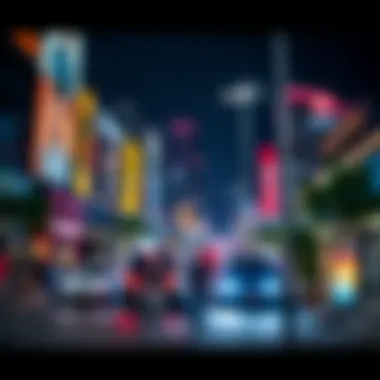
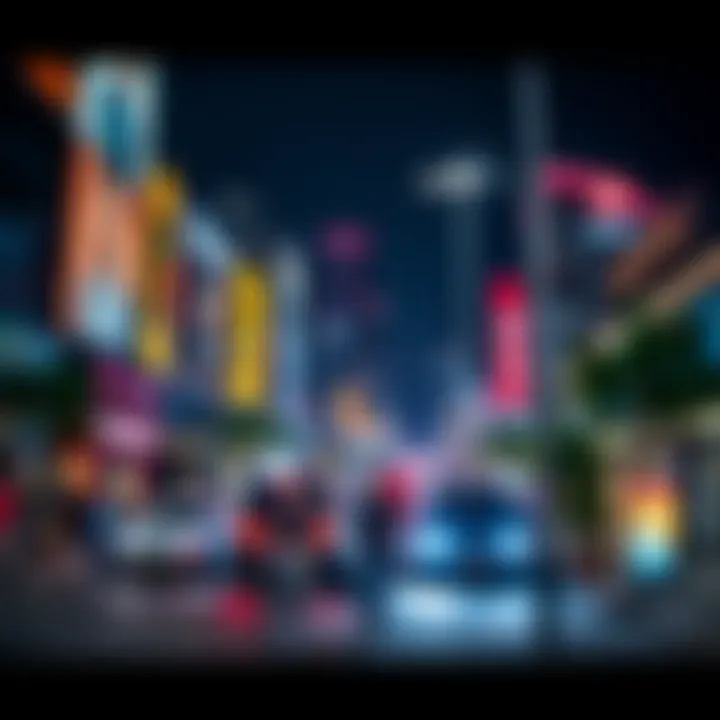
Understanding the economic impact of the Downtown area in Dubai is vital for grasping the overall dynamics that influence its market and community. This area serves as a heartbeat for the city's economy, dripping with opportunities and potential for investors, homebuyers, and businesses alike. Its vibrancy is not merely a product of its architectural wonders but also a reflection of its robust economic framework.
Benefits and Considerations
The economic health of Downtown Dubai offers diverse benefits that range from real estate investments to job creation. With the presence of the Burj Khalifa and Dubai Mall, there’s a constant inflow of tourists and expatriates, enhancing the local economy. Such iconic landmarks attract not only visitors but also international businesses looking to set up shop in a thriving environment. It presents a golden opportunity for investors aiming to make a mark in the real estate landscape.
"A thriving economic environment attracts talent and fosters innovation, making it essential for long-term investment planning."
The importance of urban planning and sustainable development initiatives also cannot be overlooked. They contribute significantly to the culture of innovation and entrepreneurship. While investments flow into the Downtown area, the overall demand for commercial and residential properties sees a notable uptick, influencing market trends.
Real Estate Market Trends
The real estate market in Downtown Dubai is characterized by its rapid pace and evolving dynamics. A walk through the district reveals a tapestry of modern residential spaces, luxury hotels, and commercial hubs that cater to the whims of a diverse population.
Current Trends
The demand for high-rise apartments remains strong, fueled by both local residents and foreign investors. There's been a marked increase in interest in luxury properties, indicating that buyers are not just interested in living spaces, but a lifestyle that embraces luxury and convenience. Property prices have generally remained resilient despite global market fluctuations, largely due to the strategic position of Downtown as a central hub.
Key factors to note in current trends include:
- A rise in off-plan sales, as investors seek to capitalize on future profits.
- Innovations in design and structure as developers aim to attract high-end clientele.
- Increased interest from expatriates seeking residential opportunities due to favorable living conditions and the lure of sophisticated urban life.
Residential offerings like luxury apartments and hotels are becoming increasingly popular, with many leading developers vying to create standout projects that catch the eye of potential buyers.
Urban Development Initiatives
Urban development initiatives in Downtown Dubai are robust and forward-thinking, contributing directly to the area’s economic success. These initiatives emphasize sustainability and smart urban planning, designed to improve the quality of life while driving economic growth.
Major Initiatives
A focus on creating public spaces, parks, and cultural institutions speaks volumes about the city’s commitment to enhancing community life. The Dubai Water Canal project, for instance, has not only opened doors to new commercial opportunities but also established a scenic and functional urban environment.
Developers are increasingly considering mixed-use projects that blend residential, commercial, and recreational spaces. This approach caters directly to the lifestyles of current and future residents while ensuring an efficient use of land.
Other notable urban developments include:
- Expansion of public transport systems, like the Dubai Metro, enhancing accessibility
- New pedestrian walkways and bike lanes, promoting healthier living options
- Improved infrastructure leading, such as roads and utilities, allowing for better connectivity
These efforts, combined with strategic visions like Dubai's 2040 Urban Master Plan, suggest a city that is not just content with the status quo but is actively seeking to innovate and adapt, making it a key area for potential investments.
Cultural and Recreational Aspects
The downtown area of Dubai serves as not just a bustling metropolis but also a hub of cultural enrichment and recreational activities. For those looking to invest or settle here, understanding these aspects allows for a more holistic view of what living downtown can offer. This section aims to spotlight the cultural institutions and the public spaces that contribute significantly to the lifestyle and identity of this vibrant area.
Cultural Institutions
Art Galleries
Art galleries in downtown Dubai are a gateway into the creative soul of the city. They showcase a plethora of both local and international artists, making them not just exhibition spaces but also cultural melting pots. One key characteristic of these galleries is their focus on contemporary art, often pushing boundaries with innovative installations and thematic exhibitions. For instance, the Alserkal Avenue area is home to numerous galleries that host avant-garde shows and community events, enhancing the local art scene.
These venues become beneficial not only for art enthusiasts but also for investors looking to tap into the cultural economy.
A unique feature of these galleries is the way they often collaborate with artists to create immersive experiences. They may offer resident artist programs or workshops, fostering a sense of community among creatives and art lovers alike. However, one potential disadvantage could be the niche nature of some exhibitions; not every piece may resonate with all demographics, which might limit the audience reach at times.
Museums
Moving on to museums, they play a pivotal role in preserving and narrating the rich history of Dubai. The Dubai Museum, for example, housed in the historic Al Fahidi Fort, offers insights into the city’s transformation from a fishing village to a global city.
Museums are especially popular choices for those interested in the heritage and cultural evolution of the UAE. A key characteristic to note is their commitment to education and awareness. They often host workshops, guided tours, and interactive exhibits, creating an engaging environment for visitors.
A unique feature of Dubai museums is how they blend traditional displays with cutting-edge technology, like virtual reality showcases that provide immersive storytelling experiences. This attracts a wide range of visitors, from locals to tourists, enhancing their appeal. However, it must be noted that the focus on technology may sometimes overshadow more traditional exhibits, possibly alienating purists who prefer classic museum experiences.
Public Spaces and Parks
Public spaces and parks in downtown Dubai add yet another layer of charm to the locale. These open areas serve as shared environments for relaxation, social interaction, and community events. Spaces such as the Burj Park invite residents and tourists alike to unwind against a backdrop of iconic structures.
The vegetation and landscaping often create a pocket of tranquility amidst the urban rush. Parks like these are not only aesthetically pleasing but provide essential recreational opportunities, from jogging pathways to children's play areas.
Unique features of these parks include their event spaces, which host various functions and festivals throughout the year, like outdoor movie nights or food festivals. However, while these parks are popular, the management of crowd control during high-traffic events can be a challenge, sometimes detracting from the overall park experience.
Ending
In summary, the cultural institutions and public parks in Dubai's downtown area serve both as attractions and as essential elements in shaping the lifestyle of its residents. Investors and homebuyers should take into account the role that these aspects play not only in property value but also in community engagement and overall quality of life.
Community and Lifestyle
When we talk about the downtown area of Dubai, it’s easy to get caught up in the glitz of its architectural marvels and bustling commercial spots. However, the thread that truly stitches this bustling tapestry together is the community and lifestyle. These elements represent the heartbeat of the area, reflecting not only how individuals engage with each other but also how various lifestyles coexist and flourish amidst the urban landscape.
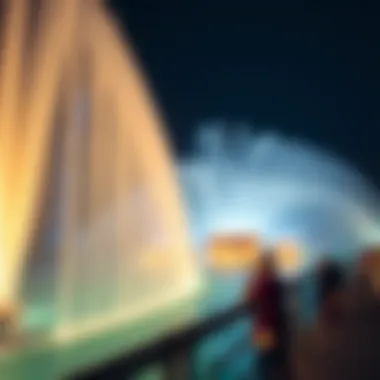
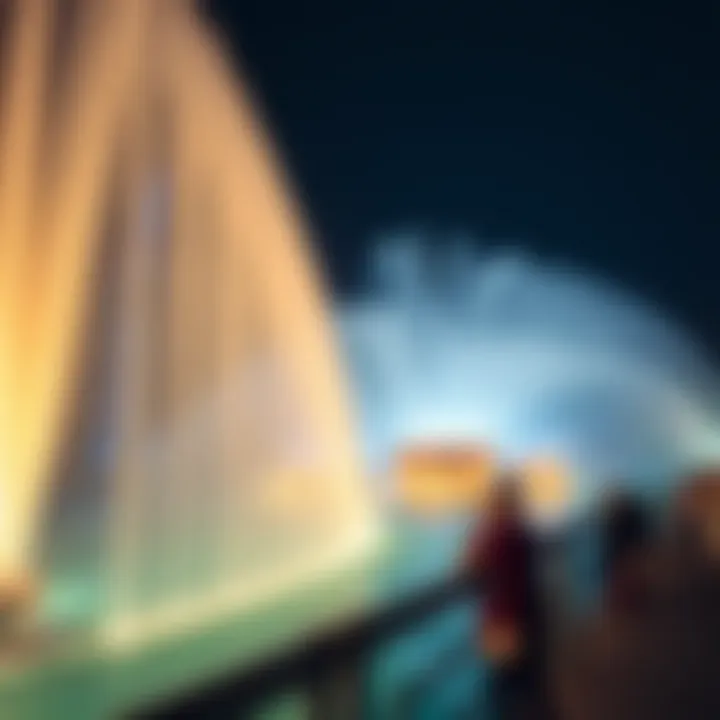
A vibrant community enhances quality of life, creating an environment where people feel connected and engaged. This is particularly significant in a multicultural city like Dubai, where a mix of nationalities converges to share experiences, traditions, and values. The variety of residential offerings, from luxury apartments to fine hotels, plays a pivotal role in shaping this lifestyle. Invested individuals must appreciate how living in such an area influences social dynamics, accessibility to amenities, and even real estate value.
Residential Offerings
Luxury Apartments
Luxury apartments in downtown Dubai are the crown jewels of the real estate market. These residences are not just places to live; they symbolize an elite lifestyle that many aspire to achieve. One key characteristic of these luxury abodes is their location, most often situated in proximity to iconic landmarks like the Burj Khalifa and the Dubai Mall. This proximity enhances not only property value but also convenience in accessing top-tier entertainment and dining options.
The unique feature of luxury apartments in this area often lies in the stunning views they offer. Residents can enjoy breathtaking panoramas of the Dubai skyline or the vibrant community spaces below, making everyday living itself a treat. However, it’s worth noting that while these living spaces promise comfort and prestige, they come at a steep price, which may put them out of reach for some potential buyers. Still, their ongoing popularity persists among expatriates and affluent locals seeking elevated living.
Hotels
When examining hotels in downtown Dubai, one sees a diverse range that caters to tourists and business travelers alike. These establishments often feature exceptional service and luxurious amenities that underline Dubai’s reputation as a global tourism hotspot. A key characteristic of these hotels is their concentration in the downtown area; many are strategically placed near major attractions, which facilitates easy access for visitors and ensures steady occupancy rates for investors.
Hotels in this area usually come with unique offerings such as rooftop pools and Michelin-star dining, enhancing the overall experience for guests. This makes them a popular choice not just for short-term stays but also for long-term investments. However, the transient nature of the hotel business can pose a risk for potential investors, especially during economic downturns when travel may decrease. Still, many view them as a solid investment due to the high demand in a booming tourism sector.
Dining and Entertainment
The dining and entertainment scene in downtown Dubai adds an extra layer of appeal to its community and lifestyle. With a myriad of international cuisines available, residents and visitors alike can partake in culinary experiences that span from local Emirati dishes to international fare. This cosmopolitan food culture enriches the social fabric, drawing in crowds and fostering a sense of togetherness.
Moreover, the area boasts various entertainment options, including art galleries and live performances, contributing to a vibrant cultural scene. This not only caters to diverse tastes but also creates opportunities for social engagement, making downtown Dubai an exciting place to call home or visit. The blend of dining and entertainment options plays an essential role in maintaining the dynamism and allure of the community.
Transportation and Accessibility
Transportation and accessibility are cornerstones that underpin the vibrancy of downtown Dubai. Their significance stems from the fact that effective transport networks not only facilitate the movement of residents and tourists but also position Dubai as a global business hub. Investors and homebuyers must grasp the multifaceted layers of transportation options available in this dynamic area—ranging from public transport systems to road infrastructure—each playing a pivotal role in enhancing the overall living experience and business viability.
Public Transport Systems
The public transport system in Dubai is a modern marvel, characterized by its efficiency and coverage. The Metropolitan Transport Authority oversees a range of services designed to cater to the growing population and the influx of tourists.
- Dubai Metro: Arguably the crown jewel of the public transport system, the Dubai Metro operates with a seamless network of routes crisscrossing the city. It's an affordable and quick means of getting to key locations such as the Burj Khalifa and the Dubai Mall. For those seeking to avoid traffic woes, this elevated train system promises hassle-free commuting.
- Buses: Complementing the Metro, the bus service offers extensive coverage across neighborhoods and commercial districts, making it accessible for those who prefer ground transport. The buses are air-conditioned, ensuring comfort, especially during the sweltering summer months.
- Water Transport: For a touch of scenic commuting, the water taxis and abras along the Dubai Creek provide a picturesque alternative. This form of transport is particularly appealing to tourists who wish to experience the city from a different vantage point.
This well-connected public transport system significantly influences property values in downtown Dubai, as ease of access is often a prime consideration for potential investors and residents.
"A city is defined by its transport links. The ease of getting from one place to another can lift an area from obscurity to recognition in just a matter of years."
Road Infrastructure
In tandem with the public transport offerings, the road infrastructure in downtown Dubai is meticulously planned, catering specifically to a diverse range of vehicles. The roads are wide and well-maintained, designed to handle the heavy traffic that is typical for this bustling city. This facet is crucial for those considering real estate investments, as ease of access can directly correlate to property desirability.
- Major Highways: Key highways such as Sheikh Zayed Road and Al Khail Road serve as vital arteries, linking downtown to other districts and facilitating smooth transitions for daily commuters and logistical transport alike.
- Accessibility: Moreover, the availability of ample parking spaces in commercial and residential zones eases concerns around vehicle ownership, making it a breeze for residents to entertain visitors or run daily errands without the stress of looking for parking.
- Traffic Management: Dubai’s Traffic Management Centre employs advanced technologies to alleviate congestion, allowing for real-time monitoring and adjustments. This proactive approach encourages a steady flow of traffic, enhancing reliability for those who depend on vehicles for commuting.
In summary, the transportation and accessibility scene in downtown Dubai fosters an environment where residents can thrive and businesses flourish. Investors eyeing opportunities in the real estate market would do well to consider how these elements shape the desirability of properties and enhance the quality of urban living.
Investment Potential
The investment potential of Dubai's downtown area is a hot topic among buyers and investors alike. This vibrant district, with its captivating skyline and myriad of attractions, offers not just a place to live or visit, but also a wealth of opportunities for financial growth. Understanding this potential is vital for anyone looking to make informed decisions in one of the world's most dynamic real estate markets.
Market Forecasts
Analyzing market forecasts in downtown Dubai reveals a trend of robust growth, driven by both local and international interest. Projections indicate that property values will continue to climb, supported by a booming economy and ongoing urban development initiatives. Notably, experts foresee an increase in demand for luxury apartments, led by the influx of expatriates and tourists drawn to the area's cultural and recreational offerings.
Key factors contributing to these forecasts include:
- Diverse Economic Drivers: Beyond tourism, sectors such as technology, finance, and logistics are establishing a presence in Dubai. This diversification helps stabilize the market against economic downturns.
- Expo 2020 Impact: The hosting of the Expo has had lasting effects on the city's appeal, with infrastructure upgrades and global visibility.
- Government Initiatives: Attractive visa regulations and ownership laws are drawing foreign investors, making the process more accessible than ever.
Forecasts suggest that by 2025, the average property value in downtown Dubai could potentially increase by as much as 5-7% annually, positioning it as a lucrative investment hub.
Risk Assessment
While the prospects appear bright, potential investors must also perform diligent risk assessment. Several factors can pose challenges that could affect overall returns.
Key risks to consider include:
- Economic Volatility: Global economic fluctuations can impact investor confidence, affecting demand for properties.
- Regulatory Changes: The legal landscape in Dubai may evolve, impacting both foreign and local investments.
- Market Saturation: While demand is currently high, the influx of new developments may eventually lead to oversupply in certain segments.
To navigate these risks, thorough market research and consulting with local real estate experts are essential. Engaging in proactive risk management strategies, such as diversifying investments across different property types or geographic areas, can also help mitigate potential downsides.
In summary, understanding the investment potential of downtown Dubai entails recognizing both the opportunities for growth and the inherent risks. By keeping a pulse on market trends and regulatory environments, investors can make sound decisions that align with their financial goals.
Challenges Facing the Downtown Area
As Dubai's downtown area continues to flourish, it's not without its hurdles. Understanding the challenges faced by this vibrant hub is vital for potential investors and homebuyers. These difficulties can influence decisions, reshape opportunities, and even affect overall market stability.
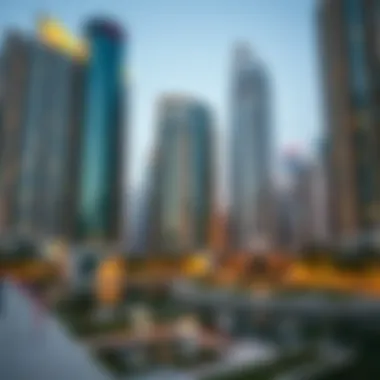
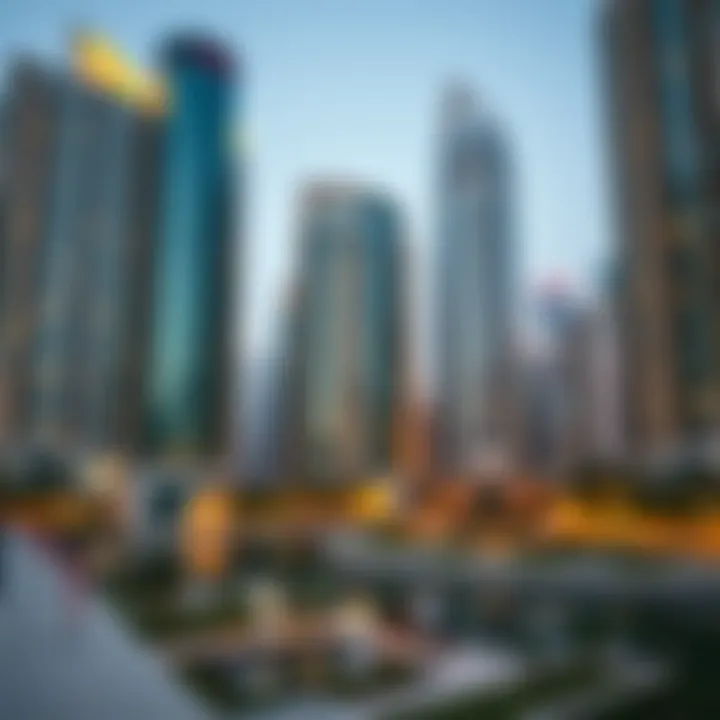
Economic Fluctuations
The economic landscape in Dubai is as dynamic as the city itself. Economic fluctuations can impact investments significantly. For instance, when the global economy is on shaky ground, markets for luxury items tend to see decreased demand. This slowdown can trickle down to real estate, particularly in high-end segments like those in the downtown area. When investors get cold feet, it's often due to unexpected swings in the economy, causing hesitation in their purchasing decisions.
Moreover, local economic conditions also play a critical role. Factors such as job growth, tourism, and consumer spending all directly influence property values. Market sentiment can shift like sand; predictions made today may not hold water tomorrow. This volatility can be unsettling for investors who prefer steady returns.
Additionally, external shocks, such as geopolitical tensions or fluctuations in oil prices, can also reverberate through Dubai’s economy, further complicating the investment landscape.
"The future of investments in Dubai's downtown will largely depend on the stability of economic conditions, both locally and globally."
Regulatory Changes
Regulatory changes can have a profound effect on the downtown area. These initiatives are often designed to improve the business environment, but they can pose challenges for existing and prospective investors. Laws regarding property ownership, zoning, and foreign investment are paramount in shaping the landscape.
Consider the real estate registration process. Conflicting regulations can arise, especially when dealing with land ownership rules and various fees that might unexpectedly surge. Even small shifts in legislation can send investors into a tailspin, prompting them to reevaluate their plans altogether.
Furthermore, taxes and fees imposed by local authorities may become more stringent as city planners seek alternative revenue streams to fund ambitious development projects. Increased taxes can eat into profit margins, thereby affecting the attractiveness of downtown properties.
In the digital age, the implementation of smart regulations surrounding affordable housing and sustainability can also introduce more complexities. Developers must navigate these new norms, which can sometimes appear convoluted or contradictory.
Navigating this regulatory maze requires due diligence and foresight, skills that are crucial for making informed investment decisions in Dubai.
In summary, while the downtown area of Dubai presents a wealth of opportunities, it's also marked by challenges that demand careful consideration. Economic fluctuations and shifting regulatory frameworks are significant factors influencing the attractiveness and viability of investments in this bustling urban landscape.
Comparative Analysis
Understanding the downtown area of Dubai requires a comparative analysis that looks beyond its borders. It’s not solely about the allure of the stunning skyline or the wealth of luxury accommodations. By positioning downtown Dubai alongside other urban districts, investors and homebuyers can glean valuable insights into market dynamics, cultural contexts, and lifestyle offerings. This part of the article sets the stage for a comprehensive evaluation that can inform the strategic decisions of potential stakeholders.
Comparison with Other Districts
Analyzing how downtown Dubai stacks up against other districts isn't a mere academic exercise; it's a strategic imperative. Take, for example, a comparison with Dubai Marina versus downtown. Here, downtown stands out with its combination of vibrant community life and proximity to landmark attractions. While Dubai Marina boasts stunning waterfront views, it often attracts a younger crowd with an emphasis on leisure. In contrast, downtown's mix of residential and commercial spaces positions it as a hub of sustainable luxury.
When discussing residential aspects, the variation between these districts is notable. In Dubai Marina, apartments often cater to short-term rentals and holidaymakers, leading to fluctuating occupancy rates. On the other hand, downtown Dubai presents a more stable real estate market with its blend of high-end developments like the Burj Khalifa and livable communities.
To draw some critical distinctions:
- Amenities: Downtown offers easy access to malls, cultural institutions, and parks, unlike the more resort-style amenities of the Marina.
- Transportation: With a more integrated transport system, downtown makes commuting seamless—a vital factor for families and expatriates needing reliable transit options.
- Cultural Vibe: The cultural offerings, including art galleries and museums, create a rich tapestry that enhances community engagement, making it more than just a living space.
Lessons from Global Cities
Cities around the globe provide an excellent backdrop for assessing downtown Dubai's potential. For instance, cities like Singapore and New York have successfully integrated mixed-use developments that cater to diverse populations and promote sustainable living. Observing how these cities manage urban space can yield useful lessons for Dubai's growth trajectory.
One notable lesson from New York's Manhattan is the importance of preserving historical sites while fostering modern innovations. Downtown Dubai is at a similar crossroads. Balancing preservation with rapid development will be pivotal for maintaining its unique character as the city evolves.
Furthermore, looking at Singapore's approach to public spaces reveals the necessity for well-thought-out community planning. The ease of movement within public areas fosters social interaction and enhances the quality of life—a factor that is becoming increasingly central to urban development strategies worldwide.
In essence, the comparative analysis allows investors and potential residents to gauge where downtown Dubai stands in relation to recognized global benchmarks. By focusing on maintaining a balance between modernity and tradition, the community can foster sustainable growth that echoes the successful practices of leading world cities.
Key Takeaway: A nuanced understanding of downtown Dubai's position relative to both local and global contexts will enable investors to make informed, strategic choices as they navigate this vibrant market.
Future Outlook
As we cast our eyes toward the horizon of Dubai's downtown area, it becomes vital to consider the Future Outlook. This part of the article serves not just as a forecast but as a blueprint of what is to come. Investors, expatriates, and homebuyers alike can benefit greatly from understanding future trends. With the natural progression of urban development, this district is not only a prime location for property but a canvas for future innovations that promise to enhance quality of life and economic viability.
A sharp focus on action plans and strategic initiatives can illuminate the benefits of investing in this area. Notably, stakeholders can gain insights into potential real estate demand, infrastructural changes, and shifts in cultural landscape that will redefine the downtown experience. For instance, developments tied to Vision 2040 will align economic aims with community needs, guiding smart investments and fostering sustainability. Moreover, understanding these factors empowers buyers to embrace informed decisions.
Vision
Vision 2040 is a watershed project aimed at transforming Dubai into an even more livable city. This ambitious framework looks to intertwine economic prosperity with sustainable development, addressing challenges such as urban congestion while enhancing connectivity and green spaces. This vision will spur developments that encompass residential units, retail hubs, and public facilities.
In practical terms, the Vision 2040 initiative envisages:
- Expansion of metro lines and additional transportation options to ease traffic
- Green buildings and renewable energy integration to boost sustainability
- Recreational zones and public parks to promote healthier lifestyles
Investors should pay close attention to how these plans unfold, as they will likely lead to increased property demand. The synergies between urban planning and the economic climate set a fertile ground for growth which is appealing for those looking to buy or invest in downtown.
Sustainable Development Goals
The commitment to Sustainable Development Goals (SDGs) in downtown Dubai plays a crucial role in shaping its future. These goals align closely with the aspirations of the local government and the international community, emphasizing the need for socially inclusive and environmentally friendly practices.
A few core elements of SDGs that are being integrated into Dubai’s urban strategy include:
- Affordable Housing: Ensuring that all social classes have access to quality housing.
- Climate Action: Implementing measures to mitigate climate change, focusing on reducing carbon footprints.
- Economic Growth: Creating job opportunities through smart investments in technology and infrastructure.
This sustainability movement is not just about mitigating risks; it is also about creating attractive opportunities for investors. As the city embraces these goals, there is a growing expectation that properties adhering to sustainable practices will command higher values, thereby offering greater returns in the long run.
The Future Outlook for downtown Dubai is not just about buildings; it's about creating communities that thrive in harmony with their environment.
As the future looms closer, it is paramount to keep an open dialogue regarding the evolving landscape. Whether you are a seasoned investor or a first-time buyer, being engaged with these developments will undoubtedly serve you well in making advantageous choices in the vibrant downtown area.




